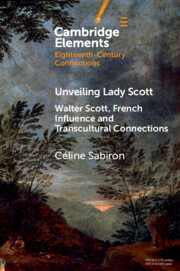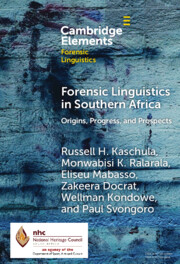Refine listing
Actions for selected content:
2232 results in Cambridge Elements

Disenchanting the Senses
- Sulfuric Discourse and the World System
-
- Published online:
- 28 November 2025
- Print publication:
- 08 January 2026
-
- Element
-
- You have access
- HTML
- Export citation

Unveiling Lady Scott
- Walter Scott, French Influence and Transcultural Connections
-
- Published online:
- 26 November 2025
- Print publication:
- 04 December 2025
-
- Element
- Export citation

How Urbanism Changes Foodways
-
- Published online:
- 26 November 2025
- Print publication:
- 08 January 2026
-
- Element
-
- You have access
- HTML
- Export citation

The Fascist Zenith
- War and Dictatorship under Axis Rule
-
- Published online:
- 26 November 2025
- Print publication:
- 11 December 2025
-
- Element
- Export citation

Politics and the Economy
-
- Published online:
- 26 November 2025
- Print publication:
- 31 December 2025
-
- Element
-
- You have access
- HTML
- Export citation

Political Meritocracy in the 21st Century
-
- Published online:
- 26 November 2025
- Print publication:
- 08 January 2026
-
- Element
-
- You have access
- HTML
- Export citation

Forensic Linguistics in Southern Africa
- Origins, Progress, and Prospects
-
- Published online:
- 25 November 2025
- Print publication:
- 18 December 2025
-
- Element
-
- You have access
- Open access
- HTML
- Export citation

Literate Workers and the Production of Early Christian Literature
-
- Published online:
- 25 November 2025
- Print publication:
- 18 December 2025
-
- Element
- Export citation

Clientelism
-
- Published online:
- 25 November 2025
- Print publication:
- 18 December 2025
-
- Element
-
- You have access
- Open access
- HTML
- Export citation

New Approaches to Assessing Behavioral and Brain Synchrony in Infant-Parent Dyads
-
- Published online:
- 21 November 2025
- Print publication:
- 18 December 2025
-
- Element
- Export citation

Phonology in Language Documentation
-
- Published online:
- 21 November 2025
- Print publication:
- 18 December 2025
-
- Element
- Export citation

Content and Language Integrated Learning (CLIL)
-
- Published online:
- 21 November 2025
- Print publication:
- 11 December 2025
-
- Element
-
- You have access
- Open access
- HTML
- Export citation

Hegel's Philosophy of Nature
-
- Published online:
- 21 November 2025
- Print publication:
- 08 January 2026
-
- Element
- Export citation

Teaching Shakespeare’s Theatre of the World
-
- Published online:
- 21 November 2025
- Print publication:
- 18 December 2025
-
- Element
-
- You have access
- HTML
- Export citation

The Contentious Politics of Global Health Movements
- Contesting Patents in Pandemic Times
-
- Published online:
- 19 November 2025
- Print publication:
- 18 December 2025
-
- Element
- Export citation

Knowledge and Narrative
-
- Published online:
- 18 November 2025
- Print publication:
- 18 December 2025
-
- Element
- Export citation

Religion and Food
-
- Published online:
- 18 November 2025
- Print publication:
- 11 December 2025
-
- Element
- Export citation

Revisiting Justice
- The Moral Meaning of Parole
-
- Published online:
- 17 November 2025
- Print publication:
- 11 December 2025
-
- Element
- Export citation

Minority Religions, the Law, and the Courts
- Cases and Consequences
-
- Published online:
- 17 November 2025
- Print publication:
- 11 December 2025
-
- Element
- Export citation

Law’s Language
- Meaning and Normativity
-
- Published online:
- 17 November 2025
- Print publication:
- 11 December 2025
-
- Element
- Export citation
